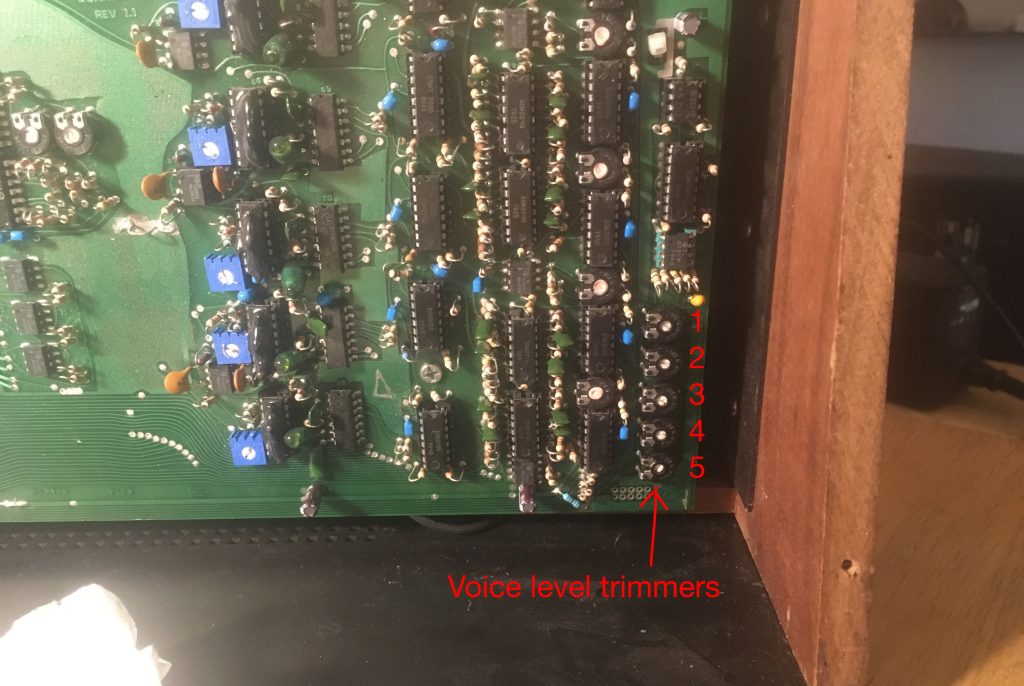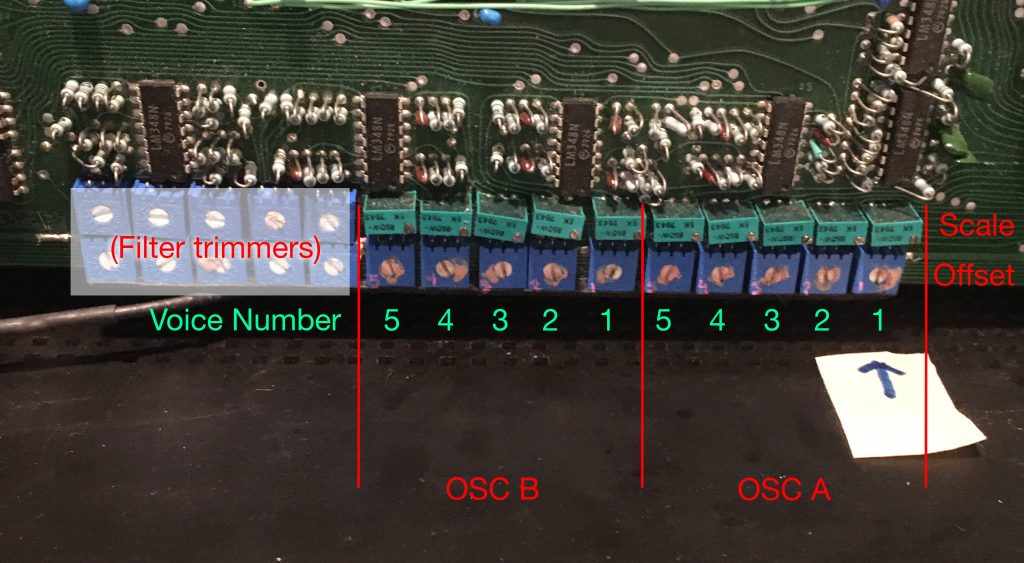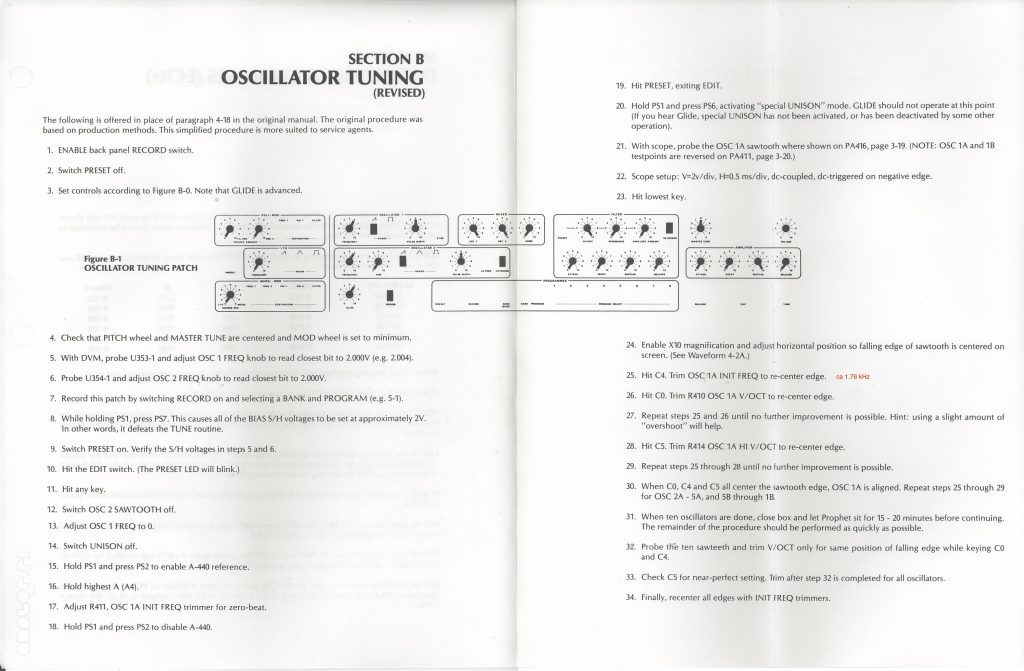The two tuning procedures (Production and Simplified methods) provided by Sequential Circuits in the Rev 2 service manual are complex, easily misinterpreted, and abstract – if you don’t have an intuitive sense of what you are doing, it’s hard to tell when you are not doing something right. It’s easy to miss a step or to do it wrong without noticing, and then the whole procedure fails.
Here I describe a method that is more similar to the standard procedure of analog poly synth tuning. I’m sure there are techs out there that don’t have a problem with SCI’s original Simplified method (attached at the end of this document), but if you are not doing this more than once a year or so, you are likely to forget something and go wrong. At least I am.
What you need
- Guitar-type tuner, or any type of tuner that you are comfortable with
- Small Screw driver

This time I used n-Track tuner App for its comprehensive way to display the information I need. I don’t use the Frequency display (here showing 92.6Hz), only the green needle and the Key display (F#).
I also don’t use my oscilloscope for tuning, it’s difficult since readings will be fluctuating constantly and also it’s hard to know what is a satisfactory value. It’s not made for musical applications.
Method, general description
- Setup
- Tune Voice 1 OSC A
- Tune Voice 1 OSC B
- Tune Voice 2 OSC A
- Tune Voice 2 OSC B
- …and so on for all 5 voices
Method, full description
Setup
- Open up your Prophet, set it in “service position” with the synth standing upright on the bottom of the chassis
- Turn it on, press Preset button, so that it’s unlit
- The Tuning Program:
Pitch bend = Center
Mod wheel = 0
All modulation off
OSC A Waveform = Saw
OSC A Frequency = 12 semitone steps up from 0
OSC B Waveform = Saw
OSC B Frequency = 12 semitone steps up from 0
OSC B Keyboard = On
OSC A Mix = 10
OSC B Mix = 10
Noise Mix = 0
Filter frequency = 10
Filt Resonance = 0

- Defeat Autotune: On the front panel, hold down Program Select Button 1 (PS1) and press PS7. This removes any compensation voltages added by the Autotune process.
To tune a voice on the Prophet 5 Rev 2 you need to be sure that you are working on the right voice. Turn down level trimmers for voice 2-5. Now only voice 1 is audible and only one out of five keys pressed will produce a sound.

- Press Unison. By doing this, all voices will play for every key pressed, but only the one whose Level trimmer is up can be heard
Tuning Voice 1 OSC A
- Set OSC A Waveform = Saw and OSC B Waveform = None.
- Make a mark on a piece of tape and put it under the Voice 1 OSC A trimmers.


- Play C4. Tune the oscillator to C with Voice 1 OSC A Offset trimmer.
- Play C0. Tune the oscillator to C with Voice 1 OSC A Scale trimmer.
- Repeat 3 and 4 until there’s no improvement.
- On the front of the Prophet, set OSC A Waveform = None, OSC B Waveform = Saw.
- Move the indicator tape to Voice 1 OSC B. Remember to move the tape every time you decide to trim a new oscillator. It’s easy to get lost and accidentally adjust the wrong trimmers.
- Play C4. Tune the oscillator to C with Voice 1 OSC B Offset trimmer.
- Play C0. Tune the oscillator to C with Voice 1 OSC B Scale trimmer.
- Repeat 8 and 9 until there’s no improvement.
- On the front panel, set OSC A Waveform = Saw, OSC B Waveform = None.
- In the low right of the Voice PCB, turn down Voice 1 Level trimmer. Turn up Voice 2 Level trimmer.
- Repeat steps 3 to 12 for voice 2, 3, 4 and 5.
- Turn up all the volume trimmers. You will have to adjust them for same level on all voices.
- Done
Notes
This particular Rev 2 was not possible to tune at all, because the Pitch Bend wheel / potentiometer assembly was unstable. After moving the PB wheel it was impossible to get it back in the exact same position. This is because the Prophet lacked a deadband circuit. The deadband adds an area in the center of the wheel where it doesn’t change voltage even if it’s moved slightly. The Rev 2 service manual does show a deadband circuit, apparently it was added after this unit was built. So I developed a separate PCB with the necessary circuitry. It can also be used to
- Transpose the keyboard voltage slightly, should there be a problem tuning the Prophet so that the Master Tune knob is centered.
- Set the bend range. Default for Prophet-5 could be 2 or 5 semitones, depending on who you ask.
The Original Simplified Tuning Method

SCI’s proposed method is probably great for those who tune a lot of Rev 2’s. It takes some effort to understand what you are doing and why.